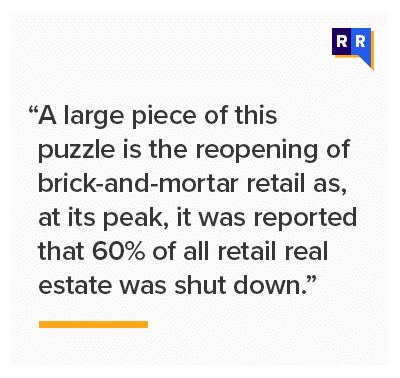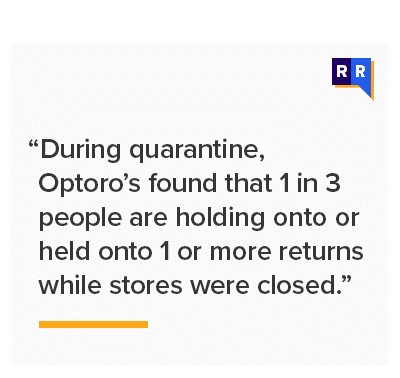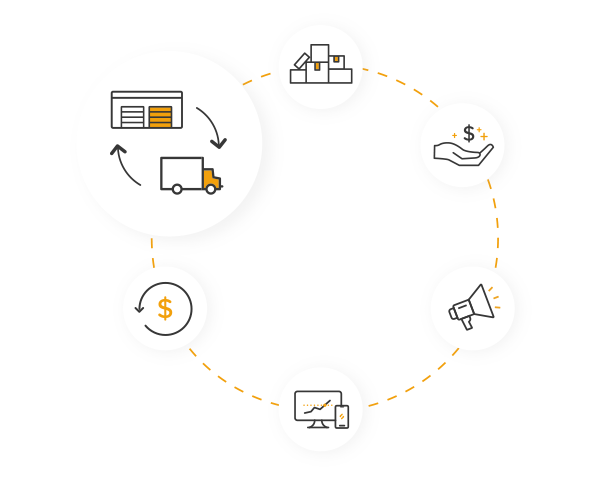This week we’re excited to partner with The Parker Avery Group as we delve into store openings and what this means for returns. The Parker Avery Group is a leading strategy and management consulting firm, whose impressive client list spans many of the world’s most prominent retail brands.
What happened in retail this week
As more states start to reopen, the rest of the country watches with anticipation to see how successful this transition back to “normal” will be. A large piece of this puzzle is the reopening of brick-and-mortar retail after nearly 60% of all retail real estate was shut down during the stay at home order peak.

Even as retailers begin their phased approach to opening stores, there are a few factors they’ll need to consider for their returns given the dramatic changes we’ve seen over the past few months.
What retailers need to consider as stores reopen:
- The new normal of the in-store returns experience
- Going the extra mile for sanitation and safety
- Preparing for an influx of customer returned inventory
Navigating the new store returns experience
On the forward side, we’ve seen an accelerated shift of companies enabling contactless payments (CNBC) and contactless checkout to alleviate hygiene concerns. And returns are no exception. The need for an express and automated returns product that allows customers to safely return in-store will be crucial for a better customer experience and to entice people back to stores.
To achieve this, retailers can use express returns mobile portals with a QR code to allow customers to queue up the return data on their smartphones ahead of time to limit time spent in store. A successful mobile returns portal should work at both stores and third-party drop off locations, such as a UPS store, to ensure the process is as seamless as possible to protect both customers and store clerks. In addition to this, delegating certain areas in store, or even designating entire stores as returns centers, will drastically speed up the returns process, reduce lines and shorten the interactions between clerks and consumers.
Once the returned items arrive at a store or distribution center, returned inventory processing (triage, evaluation, testing, refurbishing, decontamination, etc…) as well as put-away or repacking commences. New post-pandemic operating requirements may mandate updated and incremental processing activities that must be planned for. These activities are crucial to supporting the returns process and have a material impact over processing speed and the customer experience. Clearly having systems that support efficient execution of these final activities and can adapt to the expected high volumes will help ensure that the returning customer’s final exposure to the retailer is positive and may lead to future sales
Taking extra measures for safety and sanitation

As customers begin to return products in-store, operational adjustments will need to be made. Not all products are created equal, and processes should be made to accommodate different categories and surfaces. Goods with hard surfaces may be handled with a quick wipe down before returning them to the shelves for repurchase. Others, like apparel and footwear that have likely been tried on, will require a lot more management before a consumer would be willing to purchase again. While it remains unknown exactly how long the virus can “live” on various surfaces, erring on the side of caution is certainly advisable.
Going the extra mile when it comes to sanitation practices shows the consumer the retailer’s commitment to their safety, aiding in a positive customer experience. Making this a reality can be a daunting task, so we’ve broken it down into the following practices:
- Isolating returns to a specific part of the store — some already have dedicated areas, others will need to consider setting them up. Not only does this minimize time spent in store, as previously mentioned, but contains potentially contaminated goods to a confined area.
- Collecting the goods into a “safe container” — it may sound drastic, but we’ve seen some retailers going as far as to implement decontamination periods for all returns to stores before fully processing the returned items into their reverse supply chain or back on shelf.
- Letting the customer scan the product themselves — limiting the exposure to the product by the associate conducting the return — continuing the “contactless” theme.
- For goods that can be sanitized on site, executing a routine sweep to complete that exercise prior to returning the goods to the shelf.
- For goods requiring off site processing, the capture bins should double as the shipping vessel –and the scanning of product into them allows for the subsequent tracking of the goods to that facility.
With so much unknown about this virus and how it spreads, it is best to take extra precautions to keep both associates and customers as safe as possible and provide a pathway to allowing stores to return to a productive contributor to the retailer’s bottom line.
Preparing for an influx of customer returned inventory
Retailers can expect that when stores reopen, customers will need to return previously purchased merchandise. During quarantine, Optoro surveyed consumers and found that 1 in 3 people were holding onto or held onto 1 or more returns while stores were closed. Given this, we anticipate an in-store return surge alongside reopening, which will significantly impact the entire retail supply chain both operationally as well as financially. Below we examine the key areas where a surge in return volume will put pressure on retailers.

Infrastructure:
First and foremost, finding space to store this inventory while determining the optimal disposition strategy will be critical to avoid unintended disruptions to operations at both store and distribution center. Stores and DC’s already backed up with unsold spring inventory could be further burdened by a spike of returned goods awaiting processing (and possible decontamination). Additional space to accommodate new requirements for safe holding, handling or even cleaning can also consume some of the available storage space if additional areas are not procured in advance. Efficient processing and automated disposition decision making will be critical to “flattening the curve” of the returns volume.
Longer than usual transportation/delivery times for sold merchandise will also impact the lead times for inventory being routed back to centralized locations for processing, refurbishing, disposal or resale. Again, quick and efficient evaluation and handling of returned goods can help off-set transportation related delays.

Additionally some retailers should plan staffing for more complex in-store returns processing. This could happen if the retailer’s store and ecommerce systems have not been fully integrated to seamlessly process BORIS orders or online exclusive merchandise.
Financial Planning:
In general, operational expenses will increase in the short term as new procedures are designed, adapted and implemented to handle returned inventory volumes as well as incremental health and safety activities.
From a budgeting perspective, risk related to Markdowns (MD) and Mark Out of Stock (MOS) decisions will increase as the volume of these returns grow. Adding to the complexity is the fact that these MD or MOS decisions are most likely being made under a drastically reduced Spring and Fall financial sales plan. This brings in tough decisions about timing and volume of how the returns are dispositioned. Delayed markdowns of in season merchandise could help support the fiscally prudent disposition of lower margin returned merchandise. All in all, the alluded to spike in returned goods will put significant pressure on the MD/MOS budgets.
Retailers will also need to look forward in their planning processes and systems and ensure that these unique data driven events are correctly identified and cleansed in their history files so that as financial plans begin to anniversary the 2020 seasons, the spikes (or troughs) in volume, whether it be sales or returns, do not have an adverse impact on future plan architecture. There is little doubt a natural volume reset will likely occur across retail as a result of this global event, but minimizing non-repeatable outlier data points and realigning on actual trends will be an important planning exercise. Almost all retail Forecasting, Planning and Replenishment systems have various processes or parameters that can be leveraged to tune the systems so that future plans are accurate and leverage meaningful history in the planning models. Retailers with systems that help support their decision making to maximize margin, minimize costs related to returned inventory will be well positioned to manage through this unusual period of time.
Closing thoughts
There are many variables to think through as retailers examine how to best navigate the new normal we’ve all been dealt. Planning ahead for experiential, process and infrastructure changes and investing in technology to support these new initiatives can ensure a smooth and successful transition. To learn more, watch the video below.
